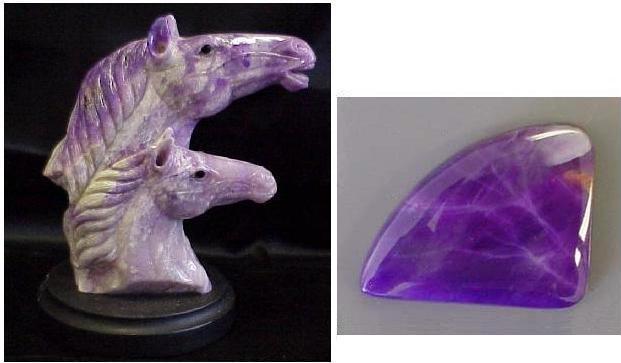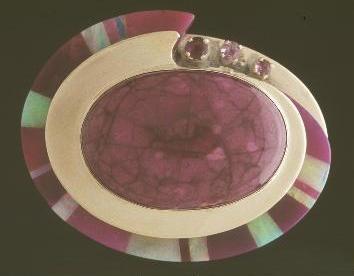( Fr- sugillite; Ger- Sugilit;
Nor- sugilitt; Rus- ![]() )
)
SUGILITE, KNa2(Fe,Mn,Al)2Li3Si12O30.

B. Sugilite.
Freeform (3.33 x 2.69 x 0.61 cm; weight - 51.08 carats). (© photo by Donna Rhoads, permission D
& J
Rare Gems, Ltd., www.djraregems.com)

OTHER NAMES:
USES: Jewelry (cabochons, freeforms and beads), eggs, spheres (some of which include associated "country rock") and carvings; also, sugilite, alone or along with other gemrocks such as lapis lazuli and rhodochrosite, has been used in the production of some high quality gem-stone inlays that have been used folr such things as pendants and the tops and sides of small boxes.
OCCURRENCE: Layers and diversely shaped zones, which -- on the basis of the other minerals present -- appear to represent a skarn, in stratiform manganese ore bodies.
NOTEWORTHY LOCALITY: Wessels mine, east of Hotazel, in the so-called Manganese fields of the Kalahari Desert of Northern Cape Province, South Africa.
REMARKS: Sugilite was named for the Japanese petrologist Ken-ichi Sugi (1901-1948), who first described the mineral from Iwagi Islet, Ochi Gun, Ehime Prefecture, southwestern Japan. The type locality sugilite, discovered in 1944, occurs as pink crystals, not as the germrock variety. The gemrock variety, manganoan sugilite, which does not resemble the type material, was not discovered until 1973 in the above mentioned Wessels mine, and it apparently was not recovered commercially until 1979.
SIMULANTS: Although not indicated to have been marketed as such, some anticipated substitutes, in that they may closely resemble sugilite, are listed by Shigley, Koivula and Fryer (1987) as "opaque or transluscent purple gem materials [that] could be confused by sight along with sugilite" seem noteworthy here: Purple or lavender jadeite, charoite, amethystine chalcedony and amethyst. In case they are so represented in the futre, there should be no real difficulty in distinguishing them from sugilite -- see JADEITE, CHAROITE and CHALCEDONY entries and note that amethyst has a sueperior hardness (H. 7).].
***Barium sulfate in a polymer matrix. - [lower
luster; lacks toughness].
***Glass of appropriate color(s). - [inferior
hardness].
Magnesite, dyed. - [typical highly irregular
color distribution; higher specific gravity]. (see Federov, 2002)
Marble, dyed
- [ low Specific Gravity (~2.65); fluorescence because of
presence of organic dyes; etc. (see Yin and Du, 2014)
Massive beryl and quartz (heat treated and dyed).
- [Dye concentrations commonly occur in fractures.]. (see Koivula,
Kammerling
and Fritsch, 1992, p.135).
***Plastic(s) of appropriate color. - [Appearance
should suffice; also, touch it with a hot point and the plastic
melts].
Quartzite, dyed -- in some cases it has been dyed selectively, better to resemble sugilite - This material, marketed as purple onyx, "could easily be mistaken visually for ... sugilite" (Koivula and Kammerling, 1990; see also Reinitz and Johnson in Moses, Reinitz and McClure, 1998). - [superior hardness].
***Synthetic sugilite - [Appearance suffices.].
Sugilite-chalcedony mixtures - noteworthy here, though NOT considered to be a simulant by some gemologists and lapidaries: Sugilite mixed with chalcedony is purple because of the sugilite component; these mixtures -- including those that are chiefly chalcedony -- constitute part or all of some items marketed as sugilite. This material, if its color satisfies the buyer, has the advantage of having an overall hardness that is greater than that of sugilite per se. Much so-called sugilite in the marketplace is this chalcedony-sugilite. - [Sugilite-chalcedony has lower specific gravity -- S.G. 2.58 -2.62 -- and commonly exhibits chalky orange fluorescence under ultraviolet radiation, whereas sugilite exhibits no fluroescence under similar radiation.].
ALSO, some anticipated substitutes, in that they may closely resemble sugilite, seem noteworthy: Amethystine chalcedony, charoite and dyed jadeite (Koivula and Kammerling, op cit.) - [no great difficulties -- see CHALCEDONY, CHAROITE and JADEITE entries.].
REFERENCE: Shigley, Koivula and Fryer, 1987.
R. V. Dietrich © 2015
Last
update: 18 February 2015
web page created by Emmett Mason